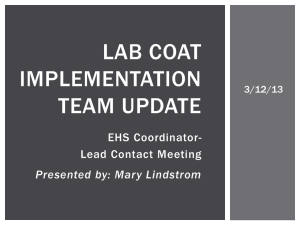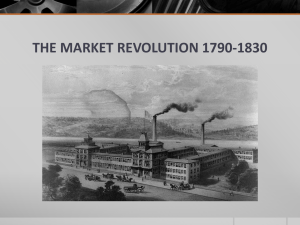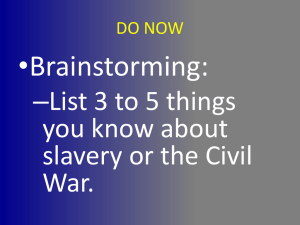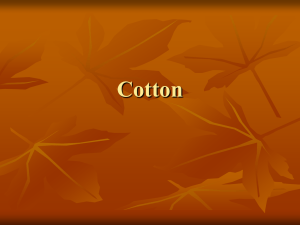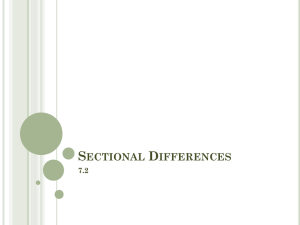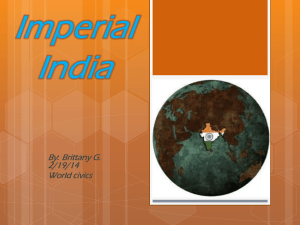Lab Coat Program Rollout - EHS
advertisement
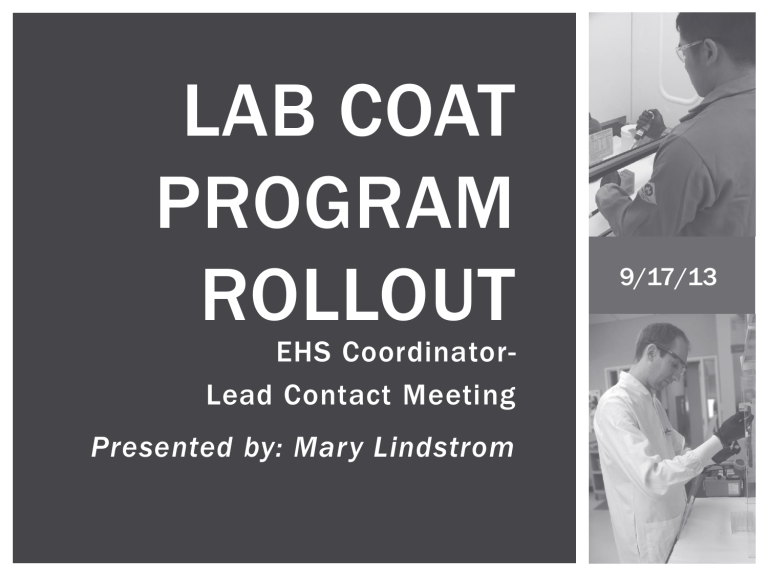
LAB COAT PROGRAM ROLLOUT EHS CoordinatorLead Contact Meeting Presented by: Mary Lindstrom 9/17/13 LAB COAT REQUIREMENT “At a minimum, a laboratory coat or equivalent protective clothing is required for work with hazardous chemicals, unsealed radioactive materials, and biological agents at BL2 or greater.” Chemical Hygiene Plan Template Revision 13 (1/31/2013) IMPLEMENTATION Create a program that will aid DLCs in providing coats people want to wear in an efficient manner. IMPLEMENTATION Goals: ✓ Update guidance for lab coat selection, use, and care. ✓ Establish MIT Preferred Vendors for providing and cleaning lab coats at a discounted price. LAB COAT GUIDANCE https://ehs.mit.edu/site/content/clothing-such-lab-coats-smocks-and-coveralls-personal-protection anufacturer. The more biological materials more and small amounts of Swan acids. Anecdotally, than cotton, the flammables. CoatInformation Information Table Model: 650 resistant to solvents. poly/cotton nknown chemical Lab Lab Coat Table more blends, but sistance. Anecdotally, Limited testing indicates poly/cotton Supplier: North Splash Star Vendor and Model Resistance/Chemic Flame breathable. Splash burns. tter for work Material with fabricsComfort will burn readily uponstill contact with FashionResistance Info Manufacturer: al Resistance Uses/Comment Vendor and ModelNo. Burnspyrophoric Resistance/Chemic Flame ids than cotton. chemicals, so poly/cotton coats Polyester/Cotton Supplier: CintasSeal May be fluid resistant. Lightweight Most common for clinical settings BlendMaterial Listed by Manufacturer: Cintas information from readily. mustbreathable. (hospitals, labs) and labs handling Info al Resistance C notResistance be worn forclinical handling such Model:Check 420 percent polyester Model: 59925 manufacturer. The more biological materials and small amounts of then percent cotton. cotton, the flammables. chemicals. Supplier: North Star Unknown chemical more 80/20 or 65/35 or 40 Manufacturer: Fashion resistance. Anecdotally, Limited testing indicates poly/cotton Polyester/Cotton Supplier: Cintas May be fluid resistant. No. Burns Ligh FR treated materials Not breathable. necessarily fluid Somewhat. No /60 common. Seal better for work with fabrics will burn readily upon contact with Blend Listed Manufacturer: Cintas Check information readily.coats bre (Recommend Model: 439 acids than cotton. pyrophoricfrom chemicals, (either 100at least %byCotton Red Kap resistant. Degraded by so poly/cotton info 65%/35% for must not be worn for handling such ot fluid resistant or cotton No. Burns Lightweight Good labsresistant where percent polyester Model: 59925 manufacturer. The or chemical primarily KP72WH acids.for More to handling is research lab chemicals. acid setting.) uid proof. Degraded less readily breathable limited and splash resistance is not a then percent cotton. cott treated withby flame solvents. Not generally Supplier: North Star No. Burns Unknown chemical 100% Cotton Supplier: Cintas Not fluid resistant or Lightweight Good for labs where acid handling is ids. Anecdotally, than concern, and there issplash some work mor retardant) tested for chemical Manufacturer: fluid proof. Degraded by less readily breathable limited and resistance is notwith a 80/20 or more 65/35 or 40 White Manufacturer: Fashion resistance. Anecdotally, Bulwark Swan acids. Anecdotally, more than concern, and there is some work with sistant to solvents. poly/cotton flammables, heat andheat flame. Supplement bre resistance. 650 to solvents. poly/cotton flammables, and flame. Supplement /60 common. Model: Seal better for work with Model:resistant KEL2LB blends, but with an apron for acid handling. blends, with an apron for acid handling. Supplier: North but Star (Recommend at least Model: 439 still burns.acids than cotton. Manufacturer: Fashion Splash still burns. 65%/35% for Seal Model: 420 esistance/Chemic chemical research labFlame Not necessarily fluid FR treated materials Supplier: Cintas Somewhat. No Better for lab settings with significant fire al Resistance Resistance (either 100 % Cotton Manufacturer: Red Kap resistant.Comfort Degraded by information. Uses/Comment hazard, with an understanding of the setting.) or primarily cotton Model: KP72WHSupplier: acids.Cintas More resistant to limitations of the testing criteria Dupont Nomex Unknown splash and Yes.for flame Bre treated with flame solvents. Not generally resistance (see background). Supplement Supplier: North Star Manufacturer: White chemical resistance. aynecessarily be fluid resistant. No. Burns Lightweight Most common foranclinical retardant) testedCintas for chemical with apron for acidsettings handling. More ot fluid Somewhat. No Better for resistant lab settings significant fire 100% Cotton Manufacturer: Supplier: Not fluid ornotwith No. Burns Ligh Bulwark resistance. costly. Will lose flame resistance with Model: KEL2LB Knight There is a claim for heck information from readily.Manufacturer: breathable. (hospitals, clinical labs) anduselabs handling laundering overby typical lifeof of readily coat. sistant. Degraded by information. hazard, with an understanding theNo White fluid proof. Degraded less bre bleach should be used by the laundry Model: OM60 chemical resistance, anufacturer. The more biological materials and small amounts of ids. More resistant to limitations of the testing Swan acids. Anecdotally, morecriteria thanfor flame service. including acids, alkalis, cotton, the Yes. flammables. lvents. Not generally resistance (see background). Supplement 650 resistant to solvents. poly/cotton Dupont Nomex Supplier: CintasModel: Unknown splash Star and Breathable. Expensive. Flame resistance is maintained Supplier: North nknown chemical Manufacturer: White chemical resistance. even with laundering, provided bleach is and most solvents, but more blends, sted for chemical with an apron for acid Manufacturer: ThereNorth is a claimBulwark for used. Good handling. for settings whereMore there but sistance. Anecdotally, Knight Limited testingnot indicates poly/cotton Supplier: Star Model: OM60 chemical resistance, may be an arc flash or flash fire. Used in specific testing breathable. sistance. costly. Will not lose flame resistance with still burns. Model: KNL6RB tter for work with fabrics will burn readily upon contact with including acids, alkalis, petrochemical industry. Manufacturer: Fashion Supplier: North Star information could not and most solvents, but Manufacturer: Bulwark Limited testingso demonstrates does coats laundering over typical use lifenomex of coat. No ids than cotton. pyrophoric chemicals, poly/cotton specific testing Model: KNL6RBSeal not burn readily on contact with be found. information could not bleach should be used by the pyrophoric so is alaundry good material must not be worn formaterials handling such Model:be420 found. for such work. service. chemicals. Polypropylene lab Various models No. No. Intended for protection from dirt, grime, Polypropylene lab Various models No. Breathable No. Bre FR treated materials Supplier: Cintas Not necessarily fluid in relatively Somewhat. No coat. available from VWR dry particulates nonthrough hazardous environment such as animal nknown splash and Yes.ECAT. Manufacturer: Breathable. Expensive. resistance maintained https://ehs.mit.edu/site/content/clothing-such-lab-coats-smocks-and-coveralls-personal-protection coat. available from VWRKap (either 100 % Cotton Red resistant. Flame Degraded by rooms.is info handling and clean Burns readily. emical resistance. even with laundering, provided bleach is through ECAT. Ex:No. VWR Cat. #414004ot fluid resistant or Burns Lightweight Good for labs where acid handling is or primarily cotton Model: KP72WH acids. More resistant to ab Coat Information Table Lab Coat Information Tab FLAME RESISTANT (FR) COATS Following the accident at UCLA, there is a movement towards requiring FR coats when working with flammable materials. MIT EHS recommends the use of FR lab coats to provide additional skin protection where the individual will be working with pyrophoric, spontaneously combustible, or extremely flammable chemicals*. *See Guidance Document for more information. FLAME RESISTANT (FR) COATS Materials FR-treated cotton – Often used for work with flammable materials. Nomex - Limited testing demonstrates Nomex does not burn readily on contact with pyrophoric materials. STYLE CONSIDERATIONS Tight cuffs High collar Snaps FR coats easily identifiable PREFERRED VENDORS In March a request for proposals was sent to 6 lab coat laundry companies. Bids were assessed on: Ability to provide lab coat styles meeting MIT needs. Flexibility in laundry options offered. Competitive prices. Willingness to assist with setup and management of lab coat systems. Agreement to MIT Terms and Conditions. Feedback from current customers. Cintas and North Star selected to be Preferred Vendors. VPF WEBSITE – “SMARTBUY” https://vpf.mit.edu/site/sourcing_procurement/what_s_new/lab_coat_services SMARTBUY - CINTAS https://vpf.mit.edu/site/sourcing_procurement/smartbuy/suppliers/cintas SMARTBUY – NORTH STAR https://vpf.mit.edu/site/sourcing_procurement/smartbuy/suppliers/north_star_rental_systems OPTIONS Laundry of rented or customer-owned coats. Launder coats for large or small groups. Weekly, biweekly, or monthly service. Standard poly/cotton lab coats, or specialty fabrics (ex. flame resistant, fluid resistant). Variety of storage systems available (ex. racks, lockers, hooks). RENTAL SYSTEM Most convenient model for reusable coats involves combination rental/laundry service. Reduced up-front cost vs. buying coats. Sizes/numbers of rented coats can be changed on demand. Automatic repairs of minor problems. Automatic replacement of old coats. PRICE Preferred Vendors will give all MIT customers, regardless of size, the same low price for laundry services. Refer to price sheets for differences in costs between North Star and Cintas. PRICE SHEET INFORMATION Laundry cost for rental lab coats Cost per coat, per week – counting all coats in circulation Price includes laundry + rental Laundry cost for customer-owned lab coats Cost per coat handed in Other charges Service charges Other weekly charges (ex. rack rental, optional insurance) One-time charges (ex. setup fees, embroidery) New lab coats for purchase CASE STUDY – SMALL GROUP North Star setting up a small lab group (10 people) that had no previous service. 2 poly/cotton coats per person, biweekly service Item Biweekly Cost Yearly Cost Lab Coat Rental $10.50 $273 Z-Rack $1.50 $39 Insurance $0.72 $18.72 Service Charge $0.51 $13.26 Total $13.23 $343.98 CASE STUDY – MULTIPLE LABS Four neighboring labs with 70 people total share a lab coat laundry service. Current service – old lab coats owned by labs, picked up weekly, $5/coat New service with Cintas 1.5 poly/cotton coats, 1.5 coats /person, weekly pickup Benefits – newer coats, proper sizing, automatic repairs Original Year Cost New Price $1220 $1310 CASE STUDY – DLC DLC currently uses North Star. As result of RFP, new prices will override original contract pricing. Poly/cotton coats for a DLC with 25 labs. Item Original Cost New Price Lab Coat Rental $0.48/coat $0.35/coat Yearly Cost/lab $258 + service $188 + service charges/equipment charges/equipment rental rental FAQS FAQs document includes answers to common questions regarding lab coat services at MIT. Also includes contact information and useful links. WHAT CAN YOU DO? Step One: Do your homework! Lab Coat Guidance Lab Coat FAQs SmartBuy pages for Cintas and North Star Step Two: Determine the current status of lab coats at your DLC(s) Centralized vs. decentralized service? Which labs do/don’t have a system in place? Is there support at your DLC for a centralized service? WHAT CAN YOU DO? Step Three: Be the Facilitator! If your labs use Preferred Vendors already, spread the word about the lower prices on their future invoices. For labs/DLCs not using a Preferred Vendor, assess whether a centralized service is possible. Benefits - Consistency across labs in coat quality and laundering. Feasibility - Physical location of labs (single building, spread around campus), support of DLC administration. If your DLC is a candidate for centralized service, contact EHS for current examples of centralized service and Preferred Vendors for an assessment of your DLC’s options. WHAT CAN YOU DO? Step Three: Be the Facilitator! If centralized service isn’t probable, reach out to EHS reps regarding their lab’s lab coat systems. EHS Rep meetings, via email, or Level II Inspections. Go over current guidelines for wearing lab coats. Provide information on Guidance documents and Preferred Vendors. Direct them to EHS and Procurement if further information is needed. Follow-up to make sure all labs in your DLC have proper lab coat supply and have a system in place to launder coats as needed. LAB COAT IMPLEMENTATION TEAM John Fucillo Scott Ide Dan Herrick Rosa Liberman Mary Lindstrom Sara Malconian Michele Miele David Petricone Emily Ranken Steve Wetzel
